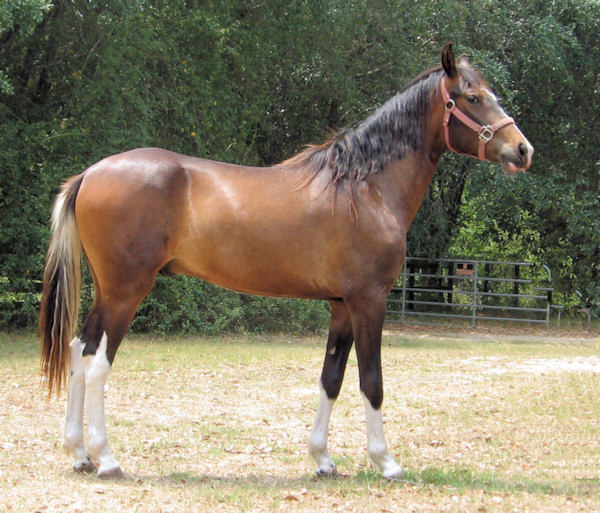Tobiano being the most prevalent pinto pattern, is found in the Puerto Rican strain of Paso Fino and in North American bred
Paso Finos of blended strains. Since tobiano is a dominant gene, the chances of offspring carrying the tobiano pattern are at least
50%. Add in the fact that when tobiano exists in the homozygous state the chances increase to 100%, making tobiano the easiest
of the Paso Fino pinto pattern to encorporate in to a breeding program.
The breeding of two heterozygous (each horse having one tobiano gene) tobiano horses can produce tobiano(Tt)
(heterozygous - one parent passed tobiano gene) 50% of the time, tobiano (TT) (homozygous - both parents passed tobiano gene)
25% of the time and SOLID (tt) (no tobiano pattern from either parent) 25% of the time.
Breeding a homozygous tobiano to a heterozygous tobiano will produce tobiano(Tt) (heterozygous - one parent passed tobiano
gene) 50% of the time, tobiano (TT) (homozygous - both parents passed tobiano gene) 50%.
The breeding of two homozygous (each horse having two tobiano genes) tobiano horses will produce tobiano (TT) (homozygous - both parents passed tobiano gene) 100% of the time.
Now, with the number of breeders increasing along with genetic testing advancements, we are seeing not only an increase in popularity but and increase in the number of Paso Finos with the tobiano pattern.
The tobiano pattern does not blend with other patterns and modifiers to create a new pattern, however individual phenotype can be influenced by the presence of the sabino pattern or white modifiers making for very unique and expressive markings.
If you love the Paso Fino breed, and enjoy the addition of color, adding tobiano to your breeding program may be a great way to express yourself.
Definitions of terms
Dominant 
 - alleles with same effect on the phenotype whether it is present in heterozygous or homozygous form
- alleles with same effect on the phenotype whether it is present in heterozygous or homozygous form
Recessive
 - alleles which only have effect on phenotype is present in homozygous form
- alleles which only have effect on phenotype is present in homozygous form
Genotype
 - the alleles possessed by an organism
- the alleles possessed by an organism
Phenotypes  - the physical expression of the genotype
- the physical expression of the genotype
Genes
 - Chemicals which are arranged in a particular pattern in the DNA which make up the chromosomes
- Chemicals which are arranged in a particular pattern in the DNA which make up the chromosomes
Genetic
 - an heritable factor that controls a specific characteristic
- an heritable factor that controls a specific characteristic
Homozygous  - having two genes for a specific characteristic –
- having two genes for a specific characteristic –
Heterozygous  - having one genes for a specific characteristic.
- having one genes for a specific characteristic.
Inheritability  - the ability to genetically pass on a specific trait
- the ability to genetically pass on a specific trait
Allele  - any of two or more genes that have the same relative position on chromosomes, responsible for alternative characteristics
- any of two or more genes that have the same relative position on chromosomes, responsible for alternative characteristics
Locus  - the position of a particular gene on a chromosome
- the position of a particular gene on a chromosome
Polygenic  - more than just one gene controlling expression
- more than just one gene controlling expression
Rabicano
 - ticking (flecking or roany type patches) typically found on the barrel, flank and tail dock
- ticking (flecking or roany type patches) typically found on the barrel, flank and tail dock
Rount 
 - larger blotches of frothy type ticking, typically found on belly, girth,under side of flanks and between hind legs.
- larger blotches of frothy type ticking, typically found on belly, girth,under side of flanks and between hind legs.
Warshield  - dark patch on underside of neck, on chest and into front legs typically found on the tobiano pinto.
- dark patch on underside of neck, on chest and into front legs typically found on the tobiano pinto.
